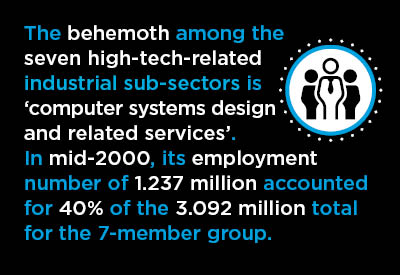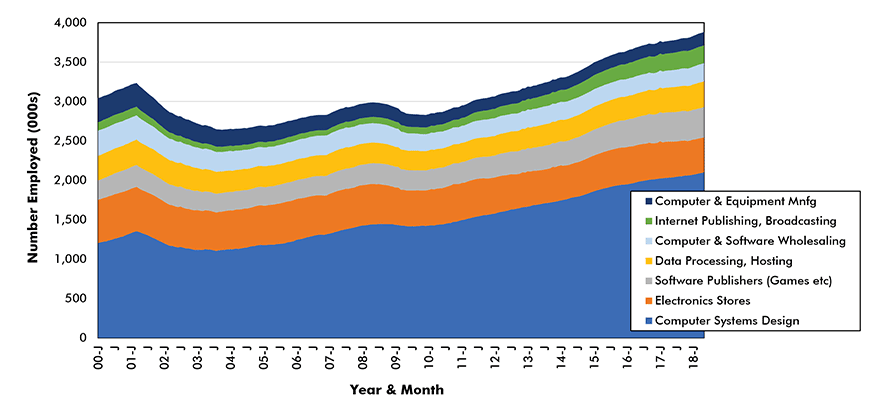Computers, the Internet and other high-tech advances have profoundly affected the workaday lives of every one of us. Many of the thought-leaders who have sparked the innovation waves have become celebrities beyond the confines of the business sector. And their companies have been richly rewarded through enormous increases in the value of their shares on the major stock markets.

Never mind that Netflix and Facebook have recently had some setbacks, the FAANG companies (Facebook, Apple, Amazon, Netflix and Google), along with many others (Twitter, Uber), have soared in value over the past decade-plus.
We’ve been living through a new industrial revolution. But there has long been one quibble raised by economists and others about these transformative times.
Historically, the birth of the auto industry, with its accompanying need for assembly plants, steel mills and gasoline stations, generated millions of new jobs.
What has been the record of ‘primary’ employment creation provided by the high-tech torch bearers?
To answer this question, I scoured through all the industrial classifications utilized by the Bureau of Labor Statistics (BLS) and for which the BLS provides monthly statistics.
The BLS makes use of NAICS – the North American Industrial Classification System.
I found the following seven designations with specific ties to computers and high-tech:
- Computer and peripheral equipment manufacturing;
- Internet publishing and broadcasting and Web search portals;
- Wholesale trade in computers and software;
- Data processing, hosting and related services;
- Software publishers (games, etc.)
- Electronics stores;
- Computer systems design and related services.
The above is based on ‘establishments’ rather than ‘professions’. Therefore, ‘software publishing’ employment includes accountants keeping track of the books. But a computer programmer with a commercial bank is counted among ‘financial services’ workers. He or she lies outside the scope of our seven.
Table 1 and Graph 1 are based on the monthly seasonally adjusted employment numbers for the seven industrial sub-sectors.
From mid-2000 to the present, there have been significant declines in employment registered by three of the seven sub-sectors: ‘retail, electronics stores’, -20.6%; ‘wholesale trade, computers and software, -26.9%’; and most startling of all, ‘durable goods, computer and peripheral equipment manufacturing’, – 42.8%.
The employment decline in the latter has largely resulted from the offshoring of such production-line work.
Moving in a positive direction, there have been major jobs advances in: ‘software publishing’, +49.8%; ‘computer systems design and related services’, +69.7%; and ‘Internet publishing and broadcasting and web search portals’, +101.5%.
The behemoth among the seven high-tech-related industrial sub-sectors is ‘computer systems design and related services’. In mid-2000, its employment number of 1.237 million accounted for 40% of the 3.092 million total for the 7-member group. At the mid-point of the current year, 2018, that share has risen to 54.1% (i.e., 2.100 million out of 3.882 million).
In mid-2000, total employment in the U.S. economy was 132.1 million jobs. It is currently 148.7 million, a climb of +12.6%.
The 7-member group total has gone from 3.092 million jobs in mid-2000 to 3.882 million at present, an advance of +25.5%.
The 7-member group (+25.5%) has doubled the economy-wide pace of jobs advance (+12.6%).
But the 7-member group’s percentage share of all jobs has stayed minimal, and risen only a little, moving from 2.3% in mid-2000 to 2.6% in mid-2018.
Those who argue that high-tech’s role in driving ‘primary’ employment has been muted have a point. ‘Offshoot’ employment gains (e.g., our previously mentioned computer programmer with a bank) are another matter and they have been prodigious.
For the construction sector there is comfort to be taken from next-generation firms building data centers and fulfilment warehouses. Plus, there is the additional office space needed to house our best visionary minds as they stretch their creative wings.
Still, it’s not quite like the ‘heady’ old days for construction firms that were filled with the building of new pulp and paper mills, cement plants and other ‘greenfield’ industrial sites.
| Mid-2000 | Mid-2018 | % Change | |||||
| 2018/2000 | |||||||
| Number | Share | Number | Share | ||||
| of Jobs | of Total | of Jobs | of Total | (B) vs (A) | |||
| (A) | (B) | ||||||
| Durable goods, computer & peripheral equipment manufacturing | 296.2 | 9.6% | 169.5 | 4.4% | -42.8% | ||
| Information services, Internet publishing & broadcasting & web search portals | 111.6 | 3.6% | 224.9 | 5.8% | 101.5% | ||
| Wholesale trade, computers & software | 314.5 | 10.2% | 230.0 | 5.9% | -26.9% | ||
| Information services, data processing, hosting & related services | 314.8 | 10.2% | 328.1 | 8.5% | 4.2% | ||
| Information services, software publishers | 256.5 | 8.3% | 384.2 | 9.9% | 49.8% | ||
| Retail trade, electronics stores | 561.2 | 18.2% | 445.4 | 11.5% | -20.6% | ||
| Professional & business services, computer systems design & related services | 1,237.1 | 40.0% | 2,099.5 | 54.1% | 69.7% | ||
| 3,091.9 | 100.0% | 3,881.6 | 100.0% | 25.5% | |||
Table: ConstructConnect.
Graph 1: ‘Primary’ Employment in U.S. High-tech Jobs

Data source (seasonally adjusted): Bureau of Labor Statistics (BLS).
Chart: ConstructConnect.











Recent Comments
comments for this post are closed